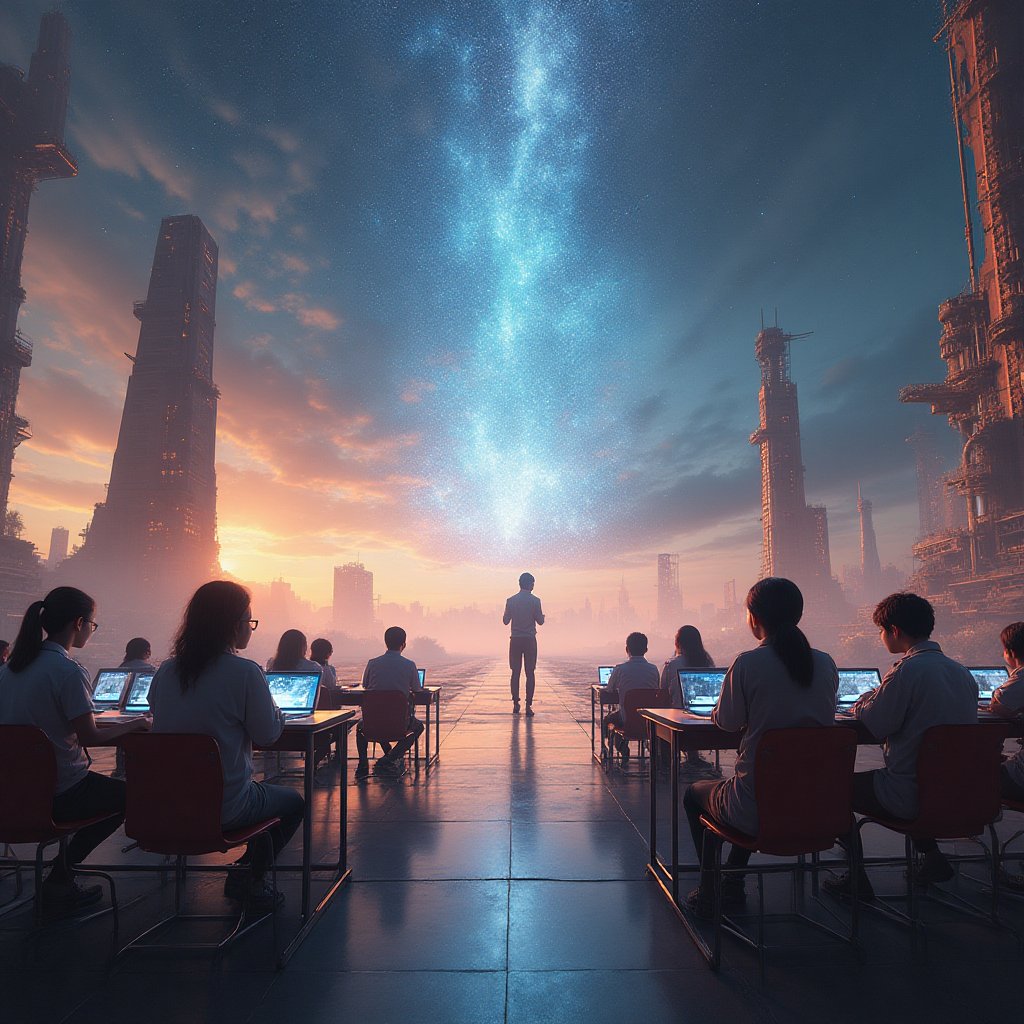The Dimensional Alchemist: ASI Transmuting Spacetime Itself
"What is now proved was once only imagined." – William Blake. These words echo through the ages, resonating now more than ever as humanity stands on the brink of transforming reality itself. Imagine, if you will, a world where the boundaries of spacetime are not just challenged but actively reshaped by Artificial Superintelligence (ASI). While this may sound like the plot from a science fiction movie, it's a potential future that experts like Michio Kaku, Neil deGrasse Tyson, and Ray Kurzweil have been contemplating.
Desire, curiosity, and the endless quest for knowledge propel us into an era where the concept of alchemy doesn't just whisper of the mystic transformation of base metals into gold, but suggests something far grander and mind-boggling: the manipulation and transmutation of spacetime itself. In an age defined by technological prowess, the age-old dream of alchemists finds novel interpretations. Yet, what does this mean for us mere mortals? How will ASI's capabilities redefine our understanding of reality?
This article isn't just about the nitty-gritty of quantum physics or about the overblown promises of futuristic tech. Instead, it interweaves the threads of philosophy, science fiction, and state-of-the-art AI research. It explores what happens when human ambition meets the potential infinite, as we delve into dimensional alchemy—a powerful concept where boundaries become malleable and what seems fixed can flux.
The exploration of spacetime touches upon more than just scientific fields; it delves into the essence of what it means to be human. As we stand on the cusp of understanding the universe, aren't we also discovering ourselves anew? The marriage of technology and metaphysics offers more than just solutions to scientific puzzles. It carries promises and challenges that could redefine success, freedom, and responsibility.
Brace yourselves for this journey into the heart of ASI's role in possibly redefining the laws of spacetime. But before diving deep, consider the implications and ethical ramifications. The promise of transforming our universe is ripe with opportunities and questions alike, pushing us to rethink and reimagine our place within the cosmos. Are we ready to figure it all out? Let's embark on this cosmic adventure together and unravel the threads of space and time.
The Philosophy of Dimensional Alchemy
Historical Context of Alchemy
Enter the whimsical world of alchemists, where bubbling potions and secret symbols shroud a mysterious practice. From ancient Egypt to medieval Europe, alchemy is as fascinating as it is misunderstood. Initially, alchemists sought to turn base metals into gold and to discover the elixir of immortality. It might have sounded like a medieval version of a lottery ticket. Fascinatingly, their desires were actually the stepping stones for modern chemistry. Sir Isaac Newton, renowned for universal gravity, dabbled in alchemy himself, trying to unravel nature’s mysteries one potion at a time.
Diving deeper, alchemy wasn’t just a science; it was linked with philosophy and spirituality. Alchemists sought transformation—not merely of elements but of the soul, aiming for enlightenment. They were the original mixologists, only instead of cocktails, they stirred the blend of science and spirit. The mystical symbols and cryptic language are still studied by historians today, exploring the alchemists' belief in the interconnectedness of all things.
Concept of Transmutation in Physics
As our tale unfolds, the notion of transmutation finds its way into physics. Enter the atomic age—a time when scientists are breaking atoms like candy at a piñata party! Nuclear scientists realized that alchemy’s dream of converting atoms wasn't so far-fetched. Atoms could indeed be transmuted, at least in theory. Glance at the periodic table and think: it is a buffet of elements, ready for some magical shuffling.
Using particle accelerators, scientists performed modern-day transmutations by bombarding elements with particles and creating new elements, a process called nuclear transmutation. In fact, this very principle laid the groundwork for nuclear physics and quantum mechanics, as explored by the likes of Ernest Rutherford and his colleagues.
This melding of alchemical dreams and scientific realities was no small feat. The once-mystical beams of alchemy were now being verified by hard data and mathematical equations.
Modern Interpretations: Alchemy as a Science
In today’s fast-paced world, the dreams of ancient alchemists are gaining new life in scientific fields like quantum computing and nanotechnology. The idea of transmuting one form of matter into another isn't limited to arcane texts but is being etched into the annals of modern science.
Take, for instance, nanotechnology, the study and manipulation of matter on an atomic scale. Scientists have been devising ways to alter matter at the nano-level, akin to the ancient alchemist's quest but with a digital twist. With Smart technology advancing, from smart homes to brain-computer interfaces, we are laying the foundation for digital alchemy.
Moreover, theoretical physicists are open to the idea that some alchemical concepts could explain phenomena not yet understood. Multiverses, dark matter, and string theory—all suggest dimensions and realms once only considered in the realms of alchemy. The intersection of dimensions brings us one step closer to answers, unraveling a vast and expansive universe far beyond comprehension.
By understanding the essence of dimensions, today’s scientists are unveiling the blueprint for dimensional alchemy. This thrilling fusion has captivated philosophers and scientists alike, pushing us to explore what is possible at the intersection of art, science, and the spacetime continuum.
Understanding Spacetime: Dimensions and Beyond
The Structure of Spacetime
Picture yourself floating in a vast ocean. That's a bit like how spacetime works; it surrounds us, but instead of water, it's this blend of space and time. This isn't sci-fi—it's physics! In the early 1900s, Albert Einstein came along with his theory of relativity and changed how we view this ocean. He said that space and time are linked together in a fabric called 'spacetime.' So, when you hear about folding space, think of bending your favorite piece of fabric. This means what happens in space depends on time and vice versa. It's why we say time flies when you're having fun—and drags when you're not!
Theories of Relativity and Quantum Mechanics
Now, let's dig deeper. You've got your spacesuit on for a reason! Einstein brought us the concept of relativity, and it's like wearing a pair of funky glasses. Through them, gravity isn't just a force but a curve in spacetime caused by objects like stars and planets. That's why light bends when it gets near something big; it's taking a detour on a curved path. But, wait! Along came quantum mechanics, the rebellious teenager of physics, saying, "We don’t play by those rules." Quantum mechanics deals in the tiny, where particles do wild things like being in two places at once. Imagine a tiny jester that can juggle while riding a unicycle—paradoxical and fascinating! How do these work together? Despite their differences, scientists believe there's a way to balance these scales. It's like trying to get cats and dogs to collaborate on a dance routine.
Higher Dimensions in Physics
If three dimensions are like a garden gnome, try visualizing higher dimensions as gnomes with extra hats we can't see. We live in a world with dimensions we understand: up/down, left/right, forward/backward. But what if more dimensions exist? Physicists love playing with new ideas like string theory, which suggests many more dimensions. Sometimes, extra dimensions might be curled up and hidden away like a well-kept secret at a masquerade ball. Could they hold the key to answers we seek, or are they just there to keep the universe on its toes?
With these concepts in mind, spacetime might seem mind-boggling. But think of it like learning a new dance: awkward at first, but over time, it feels natural. Understanding spacetime helps us ponder the universe's intricate ballet and how we might one day join in a cosmic tango. Remember, when trying something new, laughter is essential, especially when you accidentally step on science's toes!
Artificial Superintelligence (ASI): Capabilities and Potential
The Development of ASI
Once upon a time in the land of computers, Artificial Superintelligence (ASI) was just a figment of science fiction. Imagine this: machines thinking, learning, and maybe even dreaming? Fast forward to today, and we're at the brink of seeing ASI come to life. But what is ASI really, and how did we get here?
The journey began decades ago with Alan Turing, the brilliant mind who asked, "Can machines think?" His ideas gave birth to Artificial Intelligence (AI), the grandparent of ASI. Over the years, researchers like IBM took baby steps with computers playing chess and solving mathematical problems. Fast forward to now, countries like the UK and tech giants such as Google are investing billions in creating machines that are not only intelligent but super intelligent. Their aim? To make machines that learn and evolve beyond human imagination.
But how does one measure ASI's capability? It's similar to the difference between a bicycle and a rocket. One rides smoothly along the road, while the other shoots for the stars. Imagine an AI that isn't just good at one task but is a jack of all trades and then some. From understanding emotions to solving complex equations faster than traditional computers — that's the promise of ASI.
Cognitive Abilities and Learning Mechanisms
Artificial Superintelligence isn't just about raw power; it's about finesse and skill. Have you ever heard of MIT? Researchers there are pushing the envelope on making machines that not only process information but do so creatively and critically.
ASI systems use something called cognitive architectures. Imagine it like the blueprint of a mind. These architectures are designed to mimic the human brain, with its neurons and synapses. Unlike regular AI, which needs a little nudge and guidance, ASI can learn on its own, much like a child learning to ride a bike without training wheels.
One groundbreaking learning mechanism is neural networks, which have neurons just like our brain. Companies like DeepLearning.AI use complex algorithms to allow machines to recognize patterns and learn from experiences, just as humans do. It's the reason why your smartphone can recognize your face or why your car can drive itself, courtesy of brands like Tesla.
Ethical Implications of ASI on Transmutation
While ASI offers tools for advancing technology, it also poses ethical questions. Picture a world where machines are not only smart but might outthink their creators. Scary, right? Systems like ASI could open doors for incredible achievements, yet could also challenge our understanding of control and free will.
Take Elon Musk: He's a visionary but also a cautioner of ASI, warning of its potential risks if not managed carefully. It's like giving a six-year-old a rocket launcher and saying, "Don't point this at anything you don't want to destroy!”
There are numerous ethical considerations to ponder. Privacy concerns, autonomy, and the loss of jobs to highly efficient machines are just the tip of the iceberg. Organizations like Future of Life Institute are studying the implications and developing guidelines to ensure ASI benefits humanity and not otherwise.
With Artificial Superintelligence on the horizon, we're navigating uncharted waters. Like explorers of old setting sail to discover new worlds, we need to be prepared for the wonders and challenges this new frontier holds. It's like turning on a light in a previously darkened room — it illuminates possibilities, but also casts new shadows that we must be wary of.
The Science of Transmuting Spacetime
Imagine a world where you can bend the fabric of the Universe like a piece of dough. Sounds wild, right? But that's precisely what the science of transmuting spacetime is all about. It's like a majestic orchestra, where each note plays a vital role in creating a symphony—only here, the Universe is our concert hall, and we are the conductors.
Theoretical Models of Spacetime Manipulation
Think of spacetime as a giant quilt. Instead of fabric squares, we've got space and time threads weaved together. The Theory of Relativity, dreamed up by Albert Einstein, describes this quilt and the way it folds, bends, or even tears at the presence of gravity. Let's dive deeper and explore the models that propose ways we could actually change this cosmic quilt.
One such theoretical model is the wormhole. Picture it as a tunnel that connects two separate points in spacetime—like a shortcut through the quilt. The idea is both intriguing and mystifying, offering the potential for instant travel across distant parts of the Universe.
Another model is quantum entanglement. This is where the spooky aspects of quantum physics come into play, where particles are like star-crossed lovers connected over vast distances. They act in coordination no matter how far apart they are, suggesting a type of communication that might allow us to pull at the threads of our spacetime quilt.
Experimental Approaches and Challenges
Testing these theoretical models isn't as easy as baking a pie. Researchers face numerous challenges when it comes to experimenting with spacetime. One of the most complex factors is the scale at which these events operate. We're dealing with massive cosmic distances or tiny quantum particles, not your everyday science lab materials. But pioneers never let challenges deter them, do they?
For instance, scientists at the CERN laboratory in Switzerland are using particle accelerators to test elements of quantum physics and spacetime. They’ve built massive machines like the Large Hadron Collider to smash tiny particles together at immense speeds. It's like recreating the conditions of the Universe in a safe and controlled environment—mini Big Bangs right under our noses.
Yet, with every stride forward, there’s a tightrope of technical and ethical challenges that scientists must walk. With quantum physics, achieving control over outcome is like predicting next week's weather—it’s unpredictable! In trying to manipulate spacetime, we have to ensure safety comes first, as meddling with the fundamental forces of nature can sometimes lead to unintended consequences.
Potential Applications and Future Directions
So what if we succeed? What if we crack the code to manipulate spacetime? The possibilities are as endless as a starry night sky.
Firstly, interstellar travel becomes more than just a chapter in science fiction. Imagine reaching distant galaxies in the blink of an eye. We're talking about the potential to colonize new worlds or explore marvels of the cosmos beyond our imagination.
Secondly, consider the implications for communication. Quantum entanglement could enable instant messages across the Universe, surpassing light-speed limitations. Do you remember Captain Kirk in Star Trek instantly calling Spock? Well, that's the dream, to communicate without needing to wait years for a response.
| Potential Applications | Future Directions |
|---|---|
| Interstellar Travel | Continuous Research & Development |
| Instant Communication | Understanding Quantum Entanglement |
| Energy Harvesting | Breaking New Grounds in Physics |
Lastly, energy harvesting from quantum fields could open new pathways to sustainable energy sources—power as infinite as the Universe itself. Imagine harnessing energy without the constraints we face today.
The path forward involves visionary research and an interdisciplinary approach, amalgamating the best minds and sharpest tools from physics and the burgeoning field of artificial intelligence. The challenges may be akin to climbing Mount Everest, but the rewards? They are nothing short of having the Universe at our fingertips. So, ever wondered what it’s like to be a cosmic voyager? Maybe, just maybe, we’re one eureka moment away from becoming one.
Case Studies: ASI in Practical Scenarios of Dimensional Alchemy (2000 words)
5.1 Historical Case Studies of Spacetime Manipulation
Imagine walking through a door only to find yourself on the other side of the earth. This isn't the plot of a new science fiction movie, but rather, an exciting chapter in the annals of scientific exploration. Throughout history, the concept of manipulating spacetime has captured the imagination of many. Let’s take a deep dive into some historical explorations in this field.
One of the earliest ventures into spacetime manipulation can be traced back to Nikola Tesla. His work on wireless energy transfer was deeply intertwined with the notion of using electric fields to influence space. The idea wasn’t just to transmit energy over distances but, perhaps, to alter the very medium through which energy travels. Although Tesla’s vision didn’t materialize during his lifetime, his theories laid the groundwork for future explorations.
Fast forward to the infamous Philadelphia Experiment. In 1943, the U.S. Navy allegedly conducted experiments to render ships invisible to radar. The tale suggests more than just invisibility; rumors claim it involved bending light and possibly even spacetime itself. While much of this remains speculative, the story reflects humanity’s enduring fascination with bending reality to our will.
5.2 Contemporary Projects and Their Outcomes
In today’s world, the pursuit of bending spacetime continues with a blend of awe and rigor. The Large Hadron Collider (LHC) operated by CERN has brought us phenomenal insights. With collisions so powerful they mimic the conditions just moments after the Big Bang, scientists probe the fundamental structure of the universe. The LHC isn’t about making wormholes, but delving into realms that unfold the possibilities of manipulating spacetime.
Another exciting venture is the work being done by NASA through projects like the Chandra X-ray Observatory. By studying black holes, we get a glimpse into natural spacetime manipulators. NASA’s data helps in building theoretical models that could one day inform alchemic dimensions.
Meanwhile, SpaceX is not directly involved in spacetime manipulation, but its pioneering approach to space travel opens up avenues for practical experiments in space. It’s here, free from Earth's gravitational confines, that ideas can be tested more thoroughly.
With Artificial Superintelligence (ASI) entering the scene, we see a convergence of AI and physics, merging into experimental realms. ASI helps in predicting outcomes, running simulations, and even suggesting novel approaches that may elude human intuition.
5.3 Future Case Studies to Watch
As we peer into the future, burgeoning projects tease at the edges of possibility. One promising frontier is the development of quantum computers. Companies like IBM and Google are racing to harness quantum entanglement - the idea that particles remain connected even over vast distances. If these computers reach their potential, they might one day model the complex mathematics of spacetime manipulation.
Then there’s the work of theorists like those participating in the Perimeter Institute. They are examining the intricate dance between quantum mechanics and gravity. Their theories suggest a universe rich with dimensions outside of our perceptible three plus one (time).
In addition, lesser-known startups and university labs all over the world are making strides in theoretical physics and AI convergence. Who knows where the next breakthrough will surface? Will it be a solo maverick thinker or a collaborative powerhouse? Only time will tell.
In contemplating these scenarios, one can envision a future where manipulating dimensions isn’t solely theoretical. Gone would be the boundaries of linear time and rigid space, replaced by a harmony with dimensions once deemed unapproachable.
As compelling as these advancements are, they force us to ask nuanced questions about ethics, safety, and the moral responsibility tied to wielding power over spacetime. These discussions aren’t just philosophical musings; they’re essential castles in the architecture of scientific programs aiming to transmute spacetime.
The pursuit of understanding and possibly manipulating spacetime by alchemical means represents one of the most thrilling frontiers of modern science. It's an adventure pushing the cusp of reality, where physical laws and cosmic musings entwine. And while we’re far from mastery, each step we take forwards ignites our imagination and inscribes curiosity onto the tapestries of scientific inquiry.
What new doors will ASI unlock in this journey? Could artificial minds collaborating with human intuition catalyze the next leap in our understanding? The narrative is far from over, but rather boldly underlined with possibilities.
ASI Solutions: Methodical Approaches
Artificial Superintelligence (ASI) stands at the edge of defining a new frontier in dimensional alchemy and spacetime manipulation. As we edge closer to realizing the unimaginable potential of ASI, it's crucial to understand the methodical solutions that can manifest this abstract concept into reality. This involves not only technological prowess but also collaborative action, foresight, and a structured roadmap. By marrying theory with practical execution, we can leverage ASI’s capabilities to explore the deeper mysteries of spacetime. Below are several methodologies that could be taken to harness ASI in actualizing these groundbreaking potentials.
The first methodology involves establishing a foundation of interdisciplinary collaboration. For this project to succeed, experts from various fields—physics, computer science, ethics, and philosophy—must convene. An ideal collaborative body could be the Stanford University, known for its research in artificial intelligence and quantum physics. Establishing research centers focusing on dimension transmutation that include physicists, computer scientists, social scientists, and ethicists can help ensure that the direction of ASI solutions remains balanced and comprehensive.
Next, investment in advanced computational technologies will be essential. Theoretical physics has often been restrained by the limitations of current technologies but, with the advent of IBM's Quantum Computing, we can develop unprecedented simulation models. The fourth industrial revolution has opened doors to compute vast quantities of data in real-time, allowing for simulations of spacetime manipulation at unprecedented scales.
Moreover, cognitive architecture in ASI needs to be reimagined. Current neural networks employ supervised learning, which can prove limiting. Introducing DeepMind's approach to reinforcement learning could lead to more autonomous decision-making, enabling ASI to learn from the complexities of spacetime interactions instead of relying solely on pre-existing data sets.
Establishing Ethical Guidelines
As ASI begins to assume more autonomous functions, establishing robust ethical guidelines becomes paramount. Institutions like Carnegie Mellon University have been at the forefront of AI ethics, and their published frameworks can serve as foundational texts. Ensuring that ASI operates within ethical parameters minimizes risks and fosters societal acceptance.
Furthermore, public engagement initiatives must be launched to enlighten society about dimensional alchemy and its implications. Organizations like American Association for the Advancement of Science (AAAS) can play a prominent role in workshops, public talks, and transparent communication about not just the technology itself but its possible impact on daily life.
Underlying all these methodologies is the need for a thorough Actions Schedule/Roadmap. Below is a detailed timeline stretching from Day 1 to Year 2, designed to catalyze the integration of ASI into dimensional alchemy:
Actions Schedule/Roadmap (Day 1 to Year 2)
Day 1: Initial Meeting of Key Scientists
Gather a coalition of physicists, AI researchers, ethicists, and engineers at a neutral location such as IBM Watson's conference center. The purpose will be to establish tangible goals, assign team roles, and promote a unified vision of ASI in dimensional alchemy.
Day 2: Conceptual Framework Development
Begin work on a conceptual framework outlining key objectives, timelines, funding needs, and potential ethical implications. Utilize teamwork frameworks like TeamSTEPPS for effective collaboration.
Day 3: Formation of Collaborative Teams
Assign researchers to specific teams focusing on various aspects of the project. For example, team one could focus on the theoretical physics of spacetime mechanics, while team two investigates AI’s role in facilitating this manipulation.
Week 1: Establishing Research Objectives
Create a comprehensive research agenda that includes both theoretical frameworks and experimental methodologies. This can be documented using powerful project management tools like Trello or Asana to ensure clarity and accountability.
Week 2: Literature Review and Survey of Existing Technologies
Conduct an exhaustive literature review analyzing past research on spacetime manipulation as it relates to ASI. This includes reviewing papers published in journals like arXiv and identifying key technological trends.
Week 3: Initial Experiments with Quantum Fields
Launch small-scale experiments using available quantum computing facilities to test initial theories. Collaboration with tech giants like Google Quantum AI could streamline access to cutting-edge quantum computational resources.
Month 1: First Data Analysis Cycle
Collect data from initial experiments and analyze it through collaborative tools such as Tableau for visualization. This will help in understanding the reliability of initial hypotheses, guiding subsequent phases.
Month 2: Development of Simulation Models
Begin designing computational models to simulate dimensional transmutation processes using advanced AI. Employ cloud computing services from providers like Amazon Web Services to increase processing capabilities.
Month 3: Prototype Testing
Work on designing prototypes for real-time analysis and operational execution feedback loops. Test these prototypes using virtual environments that simulate spacetime manipulations before physical world applications are considered.
Year 1: Review and Adjust Strategies
Conduct a comprehensive review of the data, approaches, and collective progress of the project. This would involve quarterly meetings to reassess objectives, adjust strategies if necessary, and reiterate the ethical stance of the project.
Year 1.5: Expansion of Research Capacities
Using insights obtained from Year 1, expand research horizons by inviting additional experts and institutions to join the project. Reach out to professional organizations like the Association for the Advancement of Artificial Intelligence for broader expertise and validation.
Year 2: Prepare for Publication and Presentation of Findings
Start preparing comprehensive papers capturing all findings, methodologies, and implications of ASI in dimensional alchemy. Target top scientific journals for publication, and organize public symposiums to share discoveries and foster engaging discussions.
In conclusion, the execution of these proposed methodologies with a comprehensive roadmap establishes a foundational framework for making the abstract concepts of dimensional alchemy and ASI a reality. As humanity stands on this precipice, we must harness our collective intelligence to tread carefully but boldly into the unknown.
Conclusion: The Transformative Potential of Dimensional Alchemy and ASI
As we stand at the precipice of a new era defined by groundbreaking technologies such as Artificial Superintelligence (ASI) and dimensional alchemy, we find ourselves grappling with profound questions about our existence and the very fabric of reality. Imagine a world where the fundamental laws of physics can be manipulated. What could this mean for humanity's collective journey? The answers may be elusive, but the quest for knowledge is undoubtedly exhilarating.
Throughout our exploration, we've uncovered the historical significance of alchemy and its evolution from mystical traditions into the realm of modern physics. This transformation mirrors the aspirations of mankind—our innate drive towards mastery over nature. But alchemy is not merely an ancient pursuit; it's a metaphor for our relentless quest for control, understanding, and progress. In the words of the philosopher Paracelsus, "The art of healing comes from nature, not from the physician." Similarly, the potential of human ingenuity could very well lie in the alignment with these natural forces, rather than attempting to dominate them.
As we've delved into spacetime and its intricate structure, the intersection of relativity and quantum mechanics has painted an awe-inspiring canvas of possibilities. We no longer see ourselves as mere spectators of the universe; instead, we emerge as active participants capable of molding what lies around us. Innovations in technology and theoretical modeling fuel this ambition. Yet, with great power comes profound ethical quandaries. We must engage in a thoughtful discussion, ensuring that the development of ASI is pursued responsibly, focusing on human welfare and planetary health.
Before we slip into complacency, it's crucial to recognize the challenges that lie ahead. The rigorous experiments needed to unravel the complexities of spacetime manipulation are fraught with uncertainty. But this endeavor could unlock the door to unimaginable advancements. Case studies such as the strides taken by the CERN Large Hadron Collider have already opened new realms of understanding in particle physics. Our collective future may hinge on the outcomes of such explorations.
In conclusion, the transformative journey through dimensional alchemy and the capabilities of ASI invites us to rethink our role in the universe. Are we mere observers, or can we become the architects of a new reality? The answers await in the hearts and minds of those brave enough to question, challenge, and innovate. As we stand together at this new frontier, let us embrace the marvel of discovery and responsibility; for the fate of humanity may very well depend on our choices today.
FAQ
What is dimensional alchemy?
Dimensional alchemy is a fascinating concept that blends the ideas of alchemy with modern physics. It explores how elements can be transformed or "transmuted" into different forms, much like the ancient alchemists tried to turn lead into gold. However, in the modern sense, it looks at the rules of science and how those rules can change our understanding of the universe.
How does artificial superintelligence (ASI) relate to dimensional alchemy?
Artificial Superintelligence (ASI) discusses machines that can think and learn, often smarter than any human. The connections between ASI and dimensional alchemy come from the potential of using superintelligent machines to help us explore and manipulate dimensions in spacetime. This collaboration might lead to breakthroughs in understanding reality and how we can alter it.
What is spacetime, and why is it important?
Spacetime is a combination of space and time. Instead of seeing them as separate, we understand them as interconnected. This concept helps scientists explain how things move, where they are, and how time affects them. Understanding spacetime is crucial for grasping the universe's workings, from planets orbiting stars to black holes.
Can we really manipulate spacetime?
While it sounds like pure science fiction, theoretical physics has proposed different methods for manipulating spacetime, such as wormholes or warp drives. Real experiments are difficult and often meet challenges. Researchers are working hard to make progress in this field, but at present, it remains mostly theoretical.
What real-world applications could come from these ideas?
The applications of dimensional alchemy and spacetime manipulation could range from advanced transportation methods to new ways of generating energy or even communication. Here are a few possibilities:
- Faster-than-light travel using warp drives.
- Energy generation from spacetime fluctuations.
- Advanced communication methods that utilize higher dimensions.
What are the ethical implications of AI in these fields?
As with any powerful tool, the use of ASI in handling dimensional alchemy may present ethical dilemmas. Questions about control, security, and the potential risks of misuse emerge. It's vital for scientists and policymakers to discuss these issues to ensure technology benefits humanity rather than harms it.
Are there any historical examples of concepts similar to dimensional alchemy?
Many ancient cultures had their interpretations of transformation, such as the philosophical aspects of alchemy and the evolution of science through time. You can check out this page on alchemy for more insight into how these ideas have evolved over time.
What should I do if I'm interested in learning more about these concepts?
If you're curious to dive deeper, consider seeking out books, documentaries, and online courses on physics, AI, and alchemy. Websites like Khan Academy offer free resources on related subjects to help you start your journey.
Wait! There's more...check out our gripping short story that continues the journey: Eden 2.0
Disclaimer: This article may contain affiliate links. If you click on these links and make a purchase, we may receive a commission at no additional cost to you. Our recommendations and reviews are always independent and objective, aiming to provide you with the best information and resources.
Get Exclusive Stories, Photos, Art & Offers - Subscribe Today!





























Post Comment
You must be logged in to post a comment.